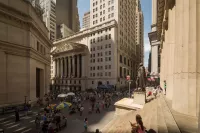Tokyo, officially Tokyo Metropolis, is the capital and most populous city of Japan. In 2023, its population exceeded 14 million. The Greater Tokyo Area is the most populous metropolitan area globally, boasting 41 million residents as of 2024, and incorporates Tokyo along with parts of six adjacent prefectures.
1906: Completion of the International Library of Children's Literature
The International Library of Children's Literature was completed in 1906.
1908: Publication of Sanshirō
In 1908, Natsume Sōseki published his novel "Sanshirō", which depicted life in Tokyo during the industrialization period.
1911: Publication of The Wild Geese
In 1911, Mori Ōgai published his novel "The Wild Geese", which depicted life in Tokyo during the industrialization period.
1914: Construction of Mitsukoshi Nihonbashi flagship store
In 1914, construction completed for Mitsukoshi Nihonbashi flagship store.
1914: Completion of Tokyo Station
Tokyo Station was completed in 1914.
1919: Establishment of the Japan Art Academy
The Japan Art Academy was established in 1919 with the purpose of bringing together leading scholars in various disciplines.
1920: Imposition of height restriction
The 31-metre height restriction, imposed on all buildings since 1920, was relaxed due to the increased demand for office buildings and advancements in earthquake-proof construction.
September 1923: Great Kanto Earthquake strikes Tokyo
On September 1923, the Great Kanto Earthquake struck Tokyo, resulting in an estimated 105,000 deaths and significant economic loss.
1923: Great Kantō earthquake damage
In 1923, Tokyo was greatly damaged by the Great Kantō earthquake.
1923: Great Kantō Earthquake exposed seismic weakness of brick buildings
The Great Kantō Earthquake in 1923 exposed the weakness of grand brick buildings to seismic shocks in Tokyo.
1923: Great Kantō Earthquake ushered in era of concrete architecture
The Great Kantō Earthquake in 1923 ushered in an era of concrete architecture in Tokyo.
1925: Refurbishment of Mitsukoshi Nihonbashi flagship store
In 1925, Mitsukoshi Nihonbashi flagship store was refurbished.
December 30, 1927: Tokyo Metro Ginza Line opening
On December 30, 1927, the Tokyo Metro Ginza Line, the first underground railway line built outside Europe and the American continents, was completed between Ueno and Asakusa.
1927: Tokyo Metro Ginza Line opening
In 1927, the Tokyo Metro Ginza Line opened, becoming the oldest underground metro line in Asia.
1929: Completion of Mitsui Headquarters
The Mitsui Headquarters was completed in 1929.
1930: Publication of The Scarlet Gang of Asakusa
In 1930, Yasunari Kawabata published "The Scarlet Gang of Asakusa", depicting the 'decadent allure' of Tokyo in the 1930s.
1931: Haneda Airport Becomes Primary Airport
Haneda Airport in Tokyo has served as the primary airport for Tokyo since 1931.
1932: May 15 incident
In 1932, the May 15 incident occurred in Tokyo.
1932: Takashimaya Nihonbashi flagship store and Wako in Ginza were completed
In 1932, the Takashimaya Nihonbashi flagship store and Wako in Ginza were completed.
1933: Tokyo House of Yasuhiko Built
In 1933, the former Tokyo House of Yasuhiko, Prince Asaka, was built in an opulent Art Deco style; the house is located within what is now the Tokyo Metropolitan Garden Art Museum in Minato.
1933: Completion of Isetan Shinjuku flagship store
The Isetan Shinjuku flagship store was completed in 1933.
1934: Tsukiji Hongan-ji Completed
In the 1930s, Tsukiji Hongan-ji was completed in 1934. It combined characteristics of both traditional Japanese and modern designs.
1934: Completion of Meiji Insurance Headquarters
The Meiji Insurance Headquarters was completed in 1934.
1936: February 26 incident
In 1936, the February 26 incident occurred in Tokyo.
1938: Tokyo gives up hosting the 1940 Summer Olympics
Due to political isolation and unstable geopolitical situations, Tokyo had to give up hosting the 1940 Summer Olympics in 1938.
1938: Highest annual precipitation in Tokyo
In 1938, annual precipitation reached its highest, measuring at 2,229.6 mm (87.78 in) in Tokyo.
June 1940: Start of Rationing
Rationing started in June 1940 as the nation braced itself for another world war.
1940: Population dwindles
Between 1940 and 1945, the population of Tokyo dwindled from 6,700,000 to less than 2,800,000.
December 1941: Attack on Pearl Harbor
On December 1941, Japan attacked the American bases at Pearl Harbor in Hawaii, entering the Second World War against the Allied Powers.
1941: Establishment of the Imperial Capital Rapid Transit Authority
From 1941 to 2004, Tokyo Metro was a public entity called the Imperial Capital Rapid Transit Authority.
April 1942: Doolittle Raid on Tokyo
On April 1942, the Doolittle Raid marked the first direct foreign attack on Tokyo.
1943: Tokyo City merges with Tokyo Prefecture
In 1943, Tokyo City merged with Tokyo Prefecture to form the Tokyo Metropolis, creating a more centralized administrative structure.
1943: Tokyo's 23 special wards created
In 1943, the 23 special wards, formerly part of Tokyo City, became self-governing municipalities, each with a mayor, council, and city status.
1943: Tokyo City area becomes 23 Special Wards
In 1943, the area that had been Tokyo City became the 23 Special Wards.
1943: Governing Structure akin to a Prefecture
Since 1943, Tokyo's governing structure has been more akin to that of a prefecture, with a Governor and Assembly taking precedence over the smaller municipal governments that make up the metropolis.
1944: Allied air bombing of Tokyo began
In late 1944, large-scale Allied air bombing of Tokyo began after the US seized control of the Mariana Islands.
1945: American "Operation Meetinghouse" raid
In 1945, the night of March 9–10 was the deadliest night of the war due to the American "Operation Meetinghouse" raid, which destroyed a significant portion of Tokyo and resulted in many casualties.
1947: Typhoon Kathleen struck Tokyo
In 1947, Typhoon Kathleen struck Tokyo, destroying 31,000 homes and killing 1,100 people.
1947: Reorganization of special wards
In 1947, the 35 pre-war special wards were reorganized into the current 23 wards.
1949: Establishment of the Science Council of Japan
The Science Council of Japan was established in 1949 to promote scientific research and the application of research findings to civilian life.
1950: Heavy industry output returns to pre-war levels
Around 1950, Tokyo did not experience fast economic growth until heavy industry output returned to pre-war levels.
1952: Allied occupation of Japan ended
Since around the time the Allied occupation of Japan ended in 1952, Tokyo's focus shifted from rebuilding to developing beyond its pre-war stature.
1956: Tokyo celebrates its 500th anniversary
During this period of rapid rebuilding, Tokyo celebrated its 500th anniversary in 1956.
1958: Typhoon Ida caused flooding in Tokyo
In 1958, Typhoon Ida dropped 400 mm of rain in a single week, causing streets to flood in Tokyo.
1962: Opening of Hotel Okura Tokyo
Hotel Okura Tokyo opened in 1962 and is considered a luxury hotel.
1964: Tokyo Summer Olympics
In 1964, Tokyo hosted the Summer Olympics, becoming the first Asian city to host the Summer Games.
1964: Summer Olympics and Paralympics hosted by Tokyo
In 1964, Tokyo was the first city in Asia to host the Summer Olympics and Paralympics.
1964: Launch of the Shinkansen and Tokyo Olympics
In 1964, the world's first dedicated high-speed railway line, the Shinkansen, was launched between Tokyo and Osaka, and the Shuto Expressway was developed to meet the increased demand brought about by the 1964 Tokyo Olympics.
1964: Yoyogi National Gymnasium designed by Kenzo Tange
The Yoyogi National Gymnasium, designed by Kenzo Tange, was completed in Tokyo in 1964.
1965: West Shinjuku redevelopment
West Shinjuku, which had been occupied by the vast Yodobashi Water Purification Centre until 1965, became the site of an entirely new business district characterized by skyscrapers surpassing 200 metres during this period.
1966: Narita Airport Site Chosen
In 1966, Narita was chosen as the site for a second airport to serve Tokyo.
1967: Ryokichi Minobe becomes governor
In 1967, Ryokichi Minobe became governor and is remembered for his welfare state policy and his 'war against pollution' policy.
1967: St. Mary's Cathedral designed by Kenzo Tange
St. Mary's Cathedral, designed by Kenzo Tange, was completed in Tokyo in 1967.
1968: Skyscrapers dominate Tokyo's skyline and return of Ogasawara Islands
Starting with the Kasumigaseki Building in 1968, skyscrapers began to dominate Tokyo's skyline. Also in 1968 the Ogasawara Islands, which had been under control of the US since the war ended, were returned.
1972: Nakagin Capsule Tower designed by Kisho Kurokawa
The Nakagin Capsule Tower, designed by Kisho Kurokawa, was completed in Tokyo in 1972.
1973: 1973 oil crisis
The 1973 oil crisis put an end to the rapid post-war recovery and development of Japan's economy.
1978: Opening of Narita Airport
After delays due to the Sanrizuka Struggle, Narita Airport finally opened in 1978 and almost all international flights were transferred there, making Haneda primarily a domestic airport.
1978: Narita International Airport opens
In 1978, Narita International Airport opened as the new gateway to the city, while the relatively small Haneda Airport switched to primarily domestic flights.
1979: G7 summit hosted by Tokyo
In 1979, Tokyo hosted a G7 summit.
1984: Lowest annual precipitation in Tokyo
In 1984, annual precipitation reached its lowest, measuring at 879.5 mm (34.63 in) in Tokyo.
1984: Financial Market Opening
In 1984, the Japanese financial market slowly started to open up.
1985: The American-led Plaza Accord
In 1985, the American-led Plaza Accord, which aimed to depreciate the US dollar, had a devastating effect on Japan's manufacturing sector, particularly affecting small to mid-size companies based in Tokyo.
1986: G7 summit hosted by Tokyo
In 1986, Tokyo hosted a G7 summit.
1987: Privatization of Japan National Railways
In 1987, JR East and JR Central were created from the privatization of Japan National Railways.
1989: Kasai Marine Park opens
The Kasai Marine Park opened in 1989.
1990: Value of the Imperial Palace
By 1990, the estimated value of the Imperial Palace surpassed that of the entire state of California.
1990: Peak of the Japanese Asset Price Bubble
In 1990, at the end of the Japanese asset price bubble, the Tokyo Stock Exchange accounted for more than 60% of the world stock market value.
1991: Tokyo Metropolitan Government Building designed by Kenzo Tange
The Tokyo Metropolitan Government Building, designed by Kenzo Tange, was completed in 1991.
1992: Opening of Hotel Chinzanso Tokyo
Hotel Chinzanso Tokyo opened in 1992 and is considered a luxury hotel.
1993: G7 summit hosted by Tokyo
In 1993, Tokyo hosted a G7 summit.
December 1995: Month with no precipitation in Tokyo
December 1995 was one of only four months on record to observe no precipitation in Tokyo.
1998: Japanese Big Bang
In 1998, the Japanese financial market accelerated its internationalization with the "Japanese Big Bang".
2000: Base level for Tokyo's greenhouse gas emissions
The year 2000 was used as the base level for Tokyo's initiative to reduce greenhouse gas emission by 25% by 2020.
2001: Decision to Expand Haneda Airport
In 2001, the decision was made to expand Haneda Airport and build new runways.
2001: Completion of the Great Mergers of Heisei
In 2001, with the completion of the Great Mergers of Heisei, Tokyo was composed of 62 municipalities: 23 special wards, 26 cities, 5 towns and 8 villages.
2003: Agricultural Land in Tokyo
As of 2003, according to the Ministry of Agriculture, Forestry and Fisheries, Tokyo had 8,460 hectares (20,900 acres) of agricultural land, placing it last among the nation's prefectures.
2003: Plans to transfer national government functions
In 2003, then-prime minister Junichiro Koizumi decided to close parliamentary discussions about plans to transfer national government functions from Tokyo to secondary capitals in other regions of Japan.
July 20, 2004: Record high temperature in Tokyo
On July 20, 2004, the record high temperature of 39.5 °C (103.1 °F) was recorded in Tokyo.
October 2004: Wettest month in Tokyo since records began
October 2004 was the wettest month in Tokyo since records began in 1876, with 780 millimeters (30 in) of rain.
2004: Privatization of Tokyo Metro
In 2004, Tokyo Metro was privatized and became entirely owned by the Japanese Government and the Tokyo Metropolitan Government.
2005: Population census in central wards of Tokyo
In the 2005 National Census, the collective population of the three central wards of Chiyoda, Chūō, and Minato was 326,000 at night, but 2.4 million during the day.
2005: National Art Center designed by Kisho Kurokawa opens
The National Art Center, designed by Kisho Kurokawa, opened in Tokyo in 2005.
2006: Tokyo enacts the "10 Year Project for Green Tokyo"
In 2006, Tokyo enacted the "10 Year Project for Green Tokyo" with the goal to be realized by 2016.
2006: Tokyo's Cost-of-Living Ranking Ends
In 2006, Tokyo's 14-year streak as the most expensive city in the world, according to the Economist Intelligence Unit, came to an end, with Oslo replacing it.
2006: Completion of Metropolitan Area Outer Underground Discharge Channel
In 2006, the Metropolitan Area Outer Underground Discharge Channel (MAOUDC), the world's largest underground floodwater diversion facility, was completed in Tokyo.
November 2007: Michelin Guide Release
In November 2007, Michelin released its first guide for fine dining in Tokyo, awarding a total of 191 stars.
2007: Green space created as part of "10 Year Project for Green Tokyo"
From 2007 to 2010, 436 ha of green space was created and 220,000 trees were planted as part of the "10 Year Project for Green Tokyo".
March 31, 2008: Natural Parks Designation
As of March 31, 2008, 36% of the total land area of the prefecture was designated as Natural Parks.
2010: Green space created as part of "10 Year Project for Green Tokyo"
From 2007 to 2010, 436 ha of green space was created and 220,000 trees were planted as part of the "10 Year Project for Green Tokyo".
2010: Rebuilt of Mistubishi building one completed
Mitsubishi building one, originally built in 1894, was rebuilt in 2010.
2010: Opening of Runway D at Haneda Airport
The opening of Runway D at Haneda Airport in 2010 marked the return of international flights to Haneda.
October 2011: Artistic Gymnastics World Championships
In October 2011, the Tokyo Metropolitan Gymnasium hosted the Artistic Gymnastics World Championships.
2011: Indirect impact of earthquake in Tokyo
In 2011, Tokyo was indirectly affected by an earthquake, with some liquefaction in landfill zones.
October 2012: Official intercensal estimate of Tokyo's population
As of October 2012, the official intercensal estimate showed 13.506 million people in Tokyo, with 9.214 million living within Tokyo's 23 wards.
August 12, 2013: Record highest low temperature recorded in Tokyo
On August 12, 2013, the record highest low temperature of 30.3 °C (86.5 °F) was recorded in Tokyo.
September 7, 2013: Tokyo selected to host the 2020 Summer Olympics
On September 7, 2013, the IOC selected Tokyo to host the 2020 Summer Olympics.
2014: Increased roadside trees in Tokyo
As of 2014, roadside trees in Tokyo increased to 950,000, and a further 300 ha of green space was added.
2016: Target year for Tokyo's "10 Year Project for Green Tokyo"
2016 was the target year for Tokyo's "10 Year Project for Green Tokyo".
2016: Yuriko Koike elected as Governor of Tokyo
In 2016, Yuriko Koike was elected as the Governor of Tokyo following the resignation of her predecessor.
2016: Plans for New National Stadium
In 2016, plans were underway to replace the National Stadium with the New National Stadium.
2017: Michelin Stars Awarded to Tokyo Restaurants
As of 2017, 227 restaurants in Tokyo were awarded Michelin stars, with 12 establishments receiving the maximum of three stars.
October 11, 2018: Opening of the Toyosu Market
On October 11, 2018, the Toyosu Market in Tokyo opened as the largest wholesale fish and seafood market in the world and one of the largest wholesale food markets of any kind.
2018: Kasai Marine Park registered under the Ramsar Convention
In 2018, the Kasai Marine Park became the first wetland in Tokyo to be registered under the Ramsar Convention.
2019: Tokyo to host Rugby World Cup Games
In 2019, Tokyo was selected to host several games for the Rugby World Cup.
2019: Tourism's Contribution to Tokyo's Economy
In 2019, tourism accounted for slightly more than one percent of Tokyo's total economic output, with 15.18 million foreign visitors spending 1.26 trillion yen, according to the Tokyo Metropolitan Government.
2020: Tokyo greenhouse gas reduction target
By 2020, Tokyo aimed to reduce greenhouse gas emissions by 25% from the 2000 level.
2020: Number of Universities in Tokyo
In 2020, Tokyo was home to 143 authorized universities.
2020: Yuriko Koike re-elected as Governor of Tokyo
In 2020, Yuriko Koike was re-elected as the Governor of Tokyo.
2020: Global Financial Centers Index Ranking
In 2020, the Global Financial Centers Index ranked Tokyo as having the fourth most competitive financial center in the world, and the second most competitive in Asia, after Shanghai.
2020: Postponement of 2020 Olympic Games
The 2020 Olympic Games were postponed as a result of the COVID-19 pandemic.
2020: Tokyo to host the 2020 Summer Olympics and Paralympics
Tokyo was selected to host the 2020 Summer Olympics and Paralympics.
August 8, 2021: Tokyo hosts postponed 2020 Summer Olympics
The 2020 Olympic Games were held from July 23 to August 8, 2021, as a result of the COVID-19 pandemic.
2021: Car Ownership Satisfaction Survey
A 2021 survey found that 81% of respondents without a car were satisfied with public transport and saw no need to own one in Tokyo.
2021: Summer Olympics and Paralympics hosted by Tokyo
In 2021, Tokyo hosted the Summer Olympics and Paralympics.
2021: Average and median ages in Tokyo
In 2021, Tokyo's average and median ages were both 45.5 years old.
2021: General election in Tokyo
In the 2021 general election, the ruling Liberal Democrats won 18 out of 25 constituencies in Tokyo, while the main opposition Constitutional Democrats won 7.
2021: Rescheduled Summer Olympics and Paralympics
In the summer of 2021, Tokyo hosted the Summer Olympics and Paralympics, which had been rescheduled from 2020 due to the COVID-19 pandemic.
January 2022: Office Space in Tokyo's 23 Special Wards
In January 2022, the 23 Special Wards of Tokyo had 73.5 million square meters of office space.
January 2022: Tokyo's foreign population before COVID-19 pandemic ended
Since the COVID-19 pandemic ended, Tokyo's foreign population has increased significantly above the January 2022 population of 546,436.
April 1, 2022: Road Length Statistics
As of April 1, 2022, the total length of roads in Tokyo is approximately 24,741 km (including 2,370 km of metropolitan roads), with a total area of approximately 190.31 km (including 46.30 km of metropolitan roads).
2022: Container Traffic at the Port of Tokyo
According to Lloyd's List, the Port of Tokyo handled 4,430,000 TEU of containers in 2022, making it the 46th largest port in the world.
2022: Government Survey on Visited Areas
According to a 2022 government survey, the most visited areas in Tokyo were...
2022: Friendship Agreements in Tokyo
As of 2022, Tokyo had twinning or friendship agreements with twelve cities and states.
2022: Gross metropolitan product
In 2022, the Greater Tokyo Area had a gross metropolitan product estimated at US$2.08 trillion.
2022: Weak Yen Starting
In 2022, years of deflation and an extremely weak yen starting due to Japan's low interest rates made the cost of living in Tokyo 31% cheaper than in New York City in 2023.
2023: Tokyo's Fortune Global 500 Companies
As of 2023, Tokyo is home to 29 of the world's 500 largest companies, as listed in the annual Fortune Global 500.
2023: Passenger Traffic at Haneda and Narita Airports
In 2023, Haneda handled 17.9 million international passengers and 60.8 million domestic passengers, while Narita handled 25.4 million international passengers and 7.7 million domestic passengers. According to a 2023 survey, Haneda is the fifth busiest airport in the world by passenger traffic.
2023: Banks Headquartered in Tokyo
In 2023, Mitsubishi UFJ, Sumitomo-Mitsui Banking Corporation, Mizuho Financial Group, all among the top 20 banks in the world by total assets, were headquartered in Tokyo.
2023: Fortune Global 500 Companies and Cost of Living
In 2023, Tokyo hosted 29 of the Fortune Global 500 companies, second only to Beijing. Also in 2023, due to deflation and a weak yen, the cost of living in Tokyo was 31% cheaper than in New York City, similar to Beijing and Manchester.
2023: Tokyo's population in 2023
In 2023, Tokyo's population in the city proper was over 14 million, making it one of the most populous urban areas in the world.
2023: Relocation of the Agency for Cultural Affairs
In 2023, the Agency for Cultural Affairs relocated from Kasumigaseki to Kyoto, making it the only central organ of the Civil Service to move out of Tokyo so far.
2023: Tokyo Green Biz Project launched
In 2023, the Tokyo Metropolitan Government launched the Tokyo Green Biz Project, aiming to increase and preserve the city's greenery over the next 100 years.
January 2024: Number of foreign nationals in Tokyo
As of January 2024, Tokyo had 647,416 foreign nationals registered as residents.
April 2024: Most populous wards and municipalities in Tokyo
According to April 2024 official estimates, Setagaya, Nerima, and Ota were the most populous wards and municipalities in Tokyo.
May 2024: Ueno Zoo Panda Population
As of May 2024, Ueno Zoo had a population of 4 giant pandas, making it one of the three zoos in Japan to have them.
May 2024: Number of buildings exceeding 150 meters in Tokyo
As of May 2024, at least 184 buildings are exceeding 150 metres (492 feet) in Tokyo.
June 2024: No official survey of race or place of birth in Tokyo
As of June 2024, there is no official survey of race or place of birth in Tokyo.
2024: Greater Tokyo Area population in 2024
As of 2024, the Greater Tokyo Area, including Tokyo and parts of six neighboring prefectures, had a population of 41 million residents, making it the most populous metropolitan area in the world.
2024: High-Net-Worth Individuals in Tokyo
In 2024, Henley & Partners estimated that there were 298,300 individuals with a net worth of more than US$1 million living in Tokyo, which was the third highest number in the world.
2024: QS Best Student Cities Ranking
In 2024, QS Best Student Cities ranked Tokyo as the second-best city for university students, after London.
2024: Yuriko Koike re-elected as Governor of Tokyo
In 2024, Yuriko Koike was re-elected as the Governor of Tokyo.
2024: Global Livability Ranking
In the 2024 edition of the Global Livability Ranking, Tokyo ranked 14th.
2024: Tokyo Metro Scheduled to Go Public
Tokyo Metro is scheduled to go public in 2024.
2027: Scheduled completion of Torch Tower
With a scheduled completion date in 2027, Torch Tower is expected to become the tallest building in Tokyo.
Mentioned in this timeline
California is a U S state on the Pacific Coast...

The stock market serves as a platform where buyers and...
China officially the People's Republic of China PRC is an...
Japan is an East Asian island country situated in the...

An earthquake is the shaking of the Earth's surface caused...

A car also known as an automobile is a wheeled...
Trending

A state of emergency grants governments extraordinary powers during crises to ensure citizens' safety This declaration typically in response to...
Drake Lindsey is an American college football quarterback currently playing for the Minnesota Golden Gophers His career is just beginning...
Mason Mount is an English professional footballer who plays as a midfielder for Manchester United in the Premier League While...

2 months ago Tyler Perry Criticized for Church Act Amidst Donation Shaming Controversy

2 months ago Cowboys Rumored to Target Maxx Crosby in Potential Trade with Raiders.
4 months ago Matt Chapman to IL with hand inflammation; Giants recall Landen Roupp.
Popular

XXXTentacion born Jahseh Dwayne Ricardo Onfroy was a controversial yet...

Ben Shapiro is a prominent American conservative political commentator media...

Candace Owens is an American conservative political commentator and author...

William Franklin Graham III commonly known as Franklin Graham is...
The Kennedy Center Honors are annual awards recognizing individuals and...

Stranger Things created by the Duffer Brothers is a popular...


